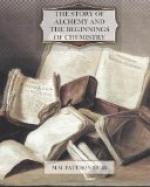As knowledge became more accurate and more concentrated, the words sulphur, salt, mercury, &c., began to be applied to distinct substances, and as these terms were still employed in their alchemical sense as compendious expressions for certain qualities common to great classes of substances, much confusion arose. Kunckel, the discoverer of phosphorus, who lived between 1630 and 1702, complained of the alchemists’ habit of giving different names to the same substance, and the same name to different substances. “The sulphur of one,” he says, “is not the sulphur of another, to the great injury of science. To that one replies that everyone is perfectly free to baptise his infant as he pleases. Granted. You may if you like call an ass an ox, but you will never make anyone believe that your ox is an ass.” Boyle is very severe on the vague and loose use of words practised by so many writers of his time. In The Sceptical Chymist (published 1678-9) he says: “If judicious men, skilled in chymical affairs, shall once agree to write clearly and plainly of them, and thereby keep men from being stunned, as it were, or imposed upon by dark and empty words; it is to be hoped that these [other] men finding, that they can no longer write impertinently and absurdly, without being laughed at for doing so, will be reduced either to write nothing, or books that may teach us something, and not rob men, as formerly, of invaluable time; and so ceasing to trouble the world with riddles or impertinences, we shall either by their books receive an advantage, or by their silence escape an inconvenience.”
Most of the alchemists taught that the elements produced what they called seed, by their mutual reactions, and the principles matured this seed and brought it to perfection. They supposed that each class, or kind, of things had its own seed, and that to obtain the seed was to have the power of producing the things which sprung from that seed.
Some of them, however, asserted that all things come from a common seed, and that the nature of the products of this seed is conditioned by the circumstances under which it is caused to develop.
Thus Michael Sendivogius writes as follows in The New Chemical Light, drawn from the fountain of Nature and of Manual Experience (17th century):—
“Wherever there is seed, Nature will work through it, whether it be good or bad.” “The four Elements, by their continued action, project a constant supply of seed to the centre of the earth, where it is digested, and whence it proceeds again in generative motions. Now the centre of the earth is a certain void place where nothing is at rest, and upon the margin or circumference of this centre the four Elements project their qualities.... The magnetic force of our earth-centre attracts to itself as much as is needed of the cognate seminal substance, while that which cannot be used for vital generation is thrust forth in the shape of stones and




